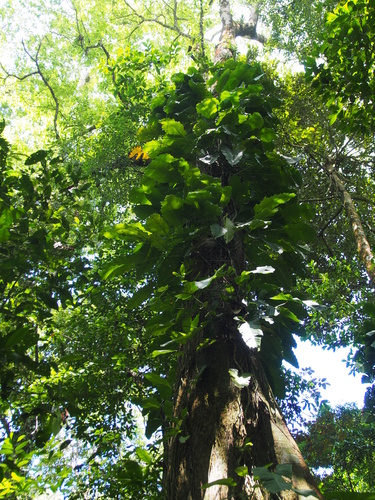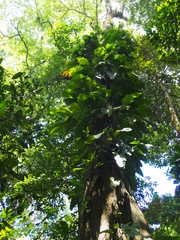

|
|
|
|
Family: Araceae
[Rhodospatha forgetii N. E. Br.] |
Epiphytic climber; caudex usually unbranched, l-2 (7) m long, to 4 cm thick, tightly appressed to its support; juvenile plants terrestrial, the stems creeping, rooting at nodes. Leaves closely spaced near apex of stem, well spaced below; petioles 25-72 cm long, canaliculate on upper surface to base of blade, vaginate-winged most of length (the wing weathering away), prominently swollen and geniculate below blade; blades oblong-lanceolate, cuspidate-acuminate at apex, usually rounded to truncate at base; midrib much raised and narrow below, the veins branching from midrib at nearly 90°, the major lateral veins 6-20 mm apart; leaves of juveniles gray-green, ovate to elliptic, acuminate, rounded to acute at base, mostly 4-10 cm long; juvenile leaves on climbing stems lanceolate-elliptic, dark green, mostly 18-35 cm long, acuminate at apex, acute to narrowly acute at base. Flowering inflorescences from upper axils; peduncles 12-23 cm long; spathe 20-44 cm long, 9-18 cm wide when expanded, white to somewhat pinkish, deciduous; spadix rose-pink, short-stipitate (the stipe to 2 cm long), slightly shorter than spathe, cylindrical, blunt at apex, ca 1.5 cm wide, sometimes recurved in fruit; flowers mostly perfect, naked; stamens 4, ca 3 mm long, tightly compressed in small cavity between adjoining pistils; ovary 3-4 mm long, the stigma round or ellipsoid; fruiting spadices usually moderately short, ca 3 cm wide. Berries less than 1 cm long, obovoid, prismatic and truncate, 2-celled, the septum broad; ovules numerous, elbow-shaped, sticking together in a gelantinous mass; seeds round, flattened, ca 1 mm long. Croat 11406. Very common in trees, to 10 m high; even more abundant as juvenile plants, occasionally carpeting the forest floor. The adults usually lose their connection with the ground. Flowers mostly throughout the rainy season, from July to December. The fruits probably develop within about 1 month after flowering. Fruiting inflorescences are seldom seen, and mature fruiting spadices seldom last long. They are apparently removed by arboreal animals, including to some extent birds. The species is possibly confused with Philodendron inaequilaterum with its large oblong leaves, but Rhodospatha may also be distinguished by having the uppermost petioles very strongly geniculate, with the blade hanging downward. Reported by Standley in the Flora of Panama as R. forgetii N. E. Brown, but the Panamanian material matches very well the type of R. wendlandii. The inflorescence on the type specimen is smaller than those in Panama, but size is quite variable even in central Panama, where the spathe varies from 20 to 40 cm in length. It is also likely that R. costaricensis Engler & Krause, R. nervosa Lundell, and R. roseospadix Mat. are synonymous with R. wendlandii. It is uncertain how the plants prevent predation on the fruit, since the fruits are much like those of Philodendron at maturity but do not have the benefit of the protective spathe before maturity. Costa Rica and Panama, probably also along all of the lowland Atlantic slope of Mexico and Central America to Colombia. In Panama, known from tropical moist forest on the Atlantic slope in the Canal Zone, from premontane wet forest in Cocle, and from tropical wet forest in Coclé and Darien. |












